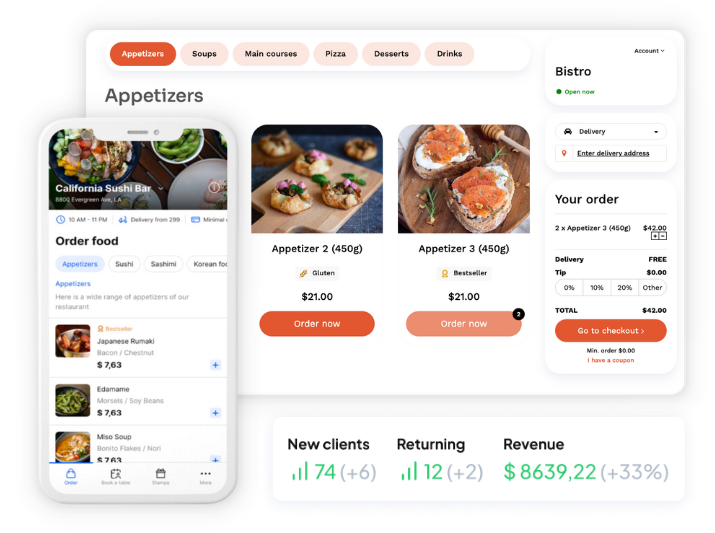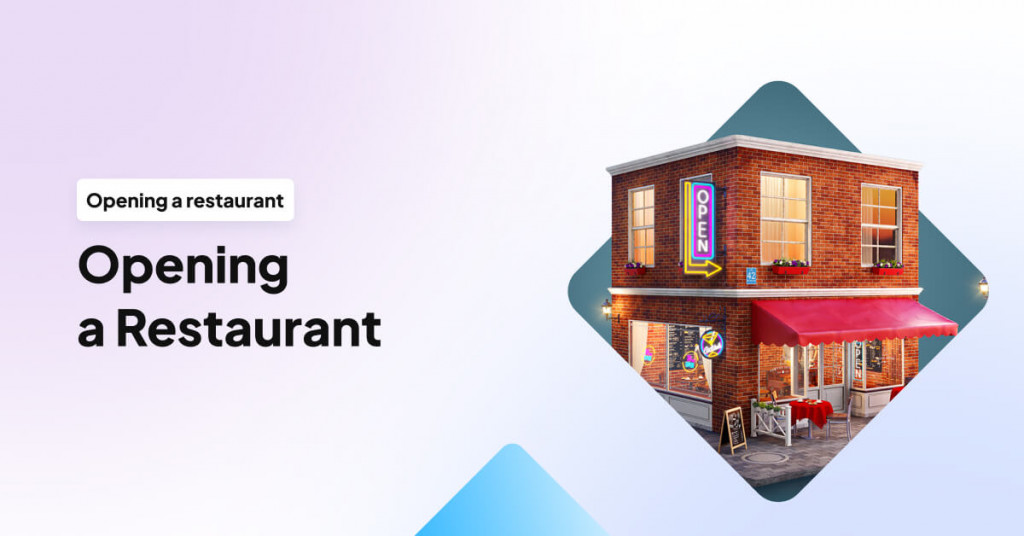Many restaurant owners navigate challenges like poor location, fluctuating food costs, and attracting customers, which can determine the success of their ventures. Effective expense management and quality offerings are essential for avoiding restaurant failure.
In this article, we will explain what is a restaurant failure rate and why restaurants fail. Let’s dive into the details!
According to CNBC, approximately 60% of newly established restaurants close within their first year, and nearly 80% cease operations before reaching their fifth anniversary.
These staggering statistics underscore the challenges inherent in the restaurant industry. To run a successful restaurant, owners must be tough and know much about the market.
Opening a restaurant requires business skills, careful analysis, and planning. Writing a restaurant business plan is a key starting point in the restaurant’s success. It needs to include, among other things, a restaurant market analysis, an investment plan (including operating costs), financial projections, and a restaurant marketing plan.

According to the National Restaurant Association, the food service industry is expected to achieve $1 trillion in sales by 2024, so restaurant sales are growing.
As the National Restaurant Association states in its report, restaurant businesses are increasingly turning to restaurant technology to tackle challenges, streamline labor, reduce expenses, and enhance operations.
To improve efficiency and productivity, they’re implementing tech solutions across various areas, such as marketing, sales, recruiting, accounting, and inventory management.
What is a restaurant failure rate?
A restaurant failure rate refers to the percentage of restaurants closing down permanently within a certain period, typically within their first year or the first few years of operation.
This rate reflects the challenges and risks of running a restaurant business, including factors like high competition, fluctuating food costs, changing consumer preferences, and economic conditions.
Main reasons why restaurants fail
Below, we’ve compiled the top reasons restaurants fail, presented without any specific order. Understanding them can help restaurant owners navigate their business more effectively and increase their chances of long-term success.
1. Poor location
A restaurant’s location is crucial for attracting customers, and factors like low visibility or high rent can hinder success. Remember that your restaurant business’s success lies in choosing a location that aligns with your target market and offers the best chance for visibility and profitability.
How to achieve success
Thoroughly research potential locations, considering factors like foot traffic, demographics, and competition before opening your restaurant. Negotiate favorable lease terms and consider alternative marketing strategies to overcome visibility challenges, such as investing in signage or partnering with nearby businesses.
2. Lack of restaurant industry experience
With sufficient experience in the restaurant industry, owners may be able to navigate its unique challenges effectively. Merely possessing culinary skills doesn’t guarantee success as a restaurant owner. Succeeding in the restaurant industry requires hands-on experience and a deep understanding of its complexities.
How to achieve success
Seek mentorship or training programs to gain insights into industry best practices and trends. Additionally, consider hiring experienced restaurant professionals to fill key roles within your establishment. Success hinges on leveraging the expertise of seasoned industry professionals and continuously learning and adapting to industry changes.
3. Too complex menu and improper pricing
A large and diverse menu can overwhelm both customers and kitchen staff, leading to inefficiencies and waste.
A wide array of options can be overwhelming for customers, making it difficult to decide and potentially leading to dissatisfaction if their chosen dish fails to meet their expectations.
Moreover, managing a large menu can strain kitchen operations, as it requires stocking a wide range of ingredients and mastering numerous recipes, leading to inefficiencies and mistakes. This complexity often results in longer wait times for customers and increases the likelihood of food waste due to ingredients needing to be utilized more efficiently.
How to achieve success
To avoid this, engage in menu engineering to refine your menu, prioritizing high-quality, profitable dishes that resonate with your restaurant’s theme and customers. Use restaurant menu pricing strategies by conducting comprehensive cost analyses to set prices that cover food costs while remaining competitive.
Success hinges on crafting a well-curated menu that optimizes profitability without overwhelming your customers, striking a balance between variety and profitability.
4. Inconsistent food quality and customer service
Inconsistent food quality and customer service pose significant risks to a restaurant’s reputation and customer loyalty. Such inconsistencies can lead to negative reviews on restaurant review sites, damaging the restaurant’s image and deterring potential loyal customers.
How to achieve success?
Prioritize investing in comprehensive staff training programs emphasizing consistency in food preparation and service delivery. Implementing quality control measures, including regular taste testing sessions and soliciting customer feedback through surveys or a restaurant feedback system, is crucial in identifying and addressing any issues.
Maintaining consistent food quality and service relies on continuous training initiatives, stringent quality control protocols, and a steadfast commitment to meeting and exceeding customer expectations to foster long-term loyalty and positive word-of-mouth recommendations.
5. Rising costs and low profitability
Rising costs and low profit margins pose significant challenges to restaurant management and ownership, particularly in an industry characterized by narrow profit margins and unpredictable cash flow.
These challenges are further compounded by escalating expenses such as food costs, influenced by market fluctuations and supply chain disruptions, as well as labor costs, driven by increasing wages and regulatory requirements.
How to achieve success?
Restaurant owners need to manage their finances by closely monitoring expenses, reviewing supplier contracts to save money, and finding ways to make their operations more efficient and less costly.
This involves keeping track of spending, negotiating better deals with suppliers, and finding ways to bring in more money.
6. Insufficient marketing efforts
There is a common belief that restaurant marketing is expensive. It doesn’t need to be; it depends on what restaurant marketing strategies and initiatives you will implement in your new restaurant.
Remember that restaurants will probably struggle to attract and retain customers without effective marketing.
How to achieve success?
To avoid restaurant failure, develop a restaurant marketing plan leveraging online and offline channels to reach your target audience.
Invest in restaurant digital marketing and consider the following ideas:
- Build a restaurant website with an online ordering feature. For that purpose, you can use an intuitive restaurant website builder.
- Create a restaurant loyalty program.
- Use social media to engage your audience.
- Use restaurant email marketing and restaurant SMS marketing to send campaigns.
Implementing these marketing strategies will help you increase visibility and drive traffic to your restaurant.
- 20 Best Restaurant Instagram Marketing Strategies & Ideas
- 70+ Best Restaurant & Food Hashtags (Examples)
- 12 Best Restaurant Facebook Marketing Strategies & Ideas
- 20 Best Restaurant Social Media Post Ideas
- 21+ Proven Ways How to Attract New Customers to Your Restaurant
- 10 Top TikTok Restaurant Marketing Ideas
- Restaurant Social Media Marketing: Ultimate Guide
Remember to create consistent restaurant branding. This includes elements such as the restaurant’s name, logo, color scheme, decor, menu design, and overall ambiance, all of which convey the restaurant’s unique story and values.
Effective branding helps attract customers, fosters loyalty, and sets your restaurant apart from competitors in a crowded market.

7. The lack of reporting
The importance of daily monitoring of restaurant operations must be balanced. It is crucial for ensuring the smooth functioning of the establishment, maintaining financial health, and identifying areas for improvement.
Detailed reports also assist in pinpointing the causes behind any financial setbacks.
How to achieve success?
Implement robust restaurant reporting tools that track key performance metrics, such as sales data, inventory levels, and customer feedback.
Analyze reports regularly to identify trends, detect issues, and make data-driven decisions to optimize operations.
8. Staffing issues
High turnover rates and rising labor costs are common challenges in the restaurant industry. Training new employees takes time and resources as they acclimate to the new work environment.
How to achieve success?
Preventing staffing issues requires investing in comprehensive training programs to equip employees with the skills and knowledge needed to excel in their roles. Implement employee retention strategies, such as offering competitive wages and benefits and fostering a positive work environment to attract and retain top talent.
Success in staffing involves wisely managing a motivated and skilled team committed to delivering exceptional service and driving business success.
9. The lack of owner involvement
When owners are not actively involved in the day-to-day operations, it can lead to disconnect and mismanagement.
How to achieve success?
Preventing the lack of owner involvement requires regular communication with staff, monitoring performance metrics, and being accessible to address concerns and make informed decisions.
Success lies in maintaining a hands-on approach, leading by example, and demonstrating a strong commitment to the business’s success.
10. Intense competition within the industry
The restaurant industry is highly competitive, requiring continuous innovation and differentiation to stand out. Running a successful restaurant requires delivering a unique value proposition that differentiates your restaurant from competitors.
How to achieve success?
Invest in market research to identify unmet customer needs and develop offerings that resonate with your target audience. Achieving success requires continuously evolving your offerings and marketing strategies to stay ahead of the competition and maintain a loyal customer base.

11. Failure to adapt
Failure to adapt to changing consumer preferences and industry trends can lead to obsolescence in the restaurant industry. As consumer tastes and preferences evolve, restaurants must remain proactive in staying informed about market trends and gathering customer feedback.
This allows them to adjust menu offerings, services, and marketing strategies to meet evolving demands and stay competitive.
How to achieve success?
Success in this area requires agility, flexibility, and a willingness to use restaurant technology and continuously innovate and reinvent the restaurant’s offerings.
By staying ahead of the curve and adapting to changing trends, restaurants can remain relevant and appealing to customers, ultimately driving long-term success and sustainability.
To prevent restaurants from failing, owners should prioritize embracing technology to streamline operations and enhance customer experience.
Consider the following ways of preventing a restaurant from failing:
- Implement an online ordering system for convenient ordering and delivery options, catering to modern consumer preferences.
- Create a user-friendly restaurant website that provides valuable information and enables online ordering, increasing accessibility for potential customers.
- Use restaurant marketing tools such as social media platforms and email and SMS campaigns to help build brand awareness and attract new patrons.
- Create a restaurant loyalty program to incentivize repeat business, reward customer loyalty, and foster long-term relationships with patrons.
What are the signs of a restaurant failing?
If you are wondering if the restaurant is failing, pay close attention to the following aspects:
- Declining revenue: A noticeable decrease in sales signals financial distress, often caused by factors like decreased customer traffic or pricing issues.
- Operational issues: Persistent restaurant problems like equipment failures or supply chain interruptions disrupt workflow and impact customer experience, leading to further revenue loss.
- Negative feedback: Increasing restaurant complaints or negative reviews indicate dissatisfaction with food quality, service, or overall experience, damaging the restaurant’s reputation. Here you can learn more about how to respond to bad restaurant reviews.
- Employee turnover: High staff turnover rates suggest underlying issues with management, morale, or workplace culture, which can affect service consistency and overall performance. Here are some suggestions on how to reduce labor costs.
- Financial strain: Difficulty meeting financial obligations, such as paying bills or managing inventory, reflects underlying financial instability and potential cash flow problems.
Key Takeaways
- Restaurant failure often stems from crucial decisions, such as location choice, menu design, and financial management, highlighting the need for careful planning and market analysis.
- The high competition within the restaurant industry underscores the importance of differentiation, innovation, and staying ahead of emerging trends.
- Poor financial management, including high operating costs, inadequate pricing strategies, and cash flow issues, significantly contributes to restaurant failures.
- Neglecting to prioritize customer satisfaction and delivering consistent quality in food and service leads to negative reviews and diminished reputation.
- A failing restaurant often need help adapting to changing consumer preferences, technological advancements, and market dynamics.
- Inefficient operations, including staffing issues, inventory mismanagement, and lack of effective systems and processes, can hinder restaurant success.
Frequently Asked Questions (FAQ)
What is the #1 reason that restaurants fail?
The number one reason restaurants fail can vary depending on factors such as bad location, market conditions, and management practices. However, one commonly cited reason for restaurant failure is poor financial management, including high operating costs, inadequate pricing strategies, and cash flow problems. Effective financial management is crucial for a restaurant’s long-term success and sustainability.
Why do restaurants have such a high failure rate?
According to Synergy Restaurant Consultants, most new restaurants fail due to inexperience and ineffective leadership. New owners may select not good locations, need help to lead their team effectively, face challenges in managing finances, or provide food that fails to meet quality standards.
Why do 90 percent of restaurants fail?
Why do so many restaurants fail?
Many restaurants fail due to
- poor financial management,
- high operating costs,
- ineffective marketing strategies,
- location issues,
- lack of differentiation.
Additionally, insufficient understanding of customer preferences, inconsistent quality in food and service, and challenges in staffing and operations contribute to the failure rate.














